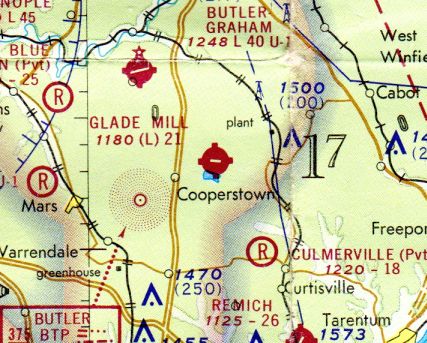On October 22, 1973, I flew with the Big Captain himself, Bill McCowin, for my instrument check ride. I don't remember what we did, but it lasted one hour. I'm sure we flew an ILS at Allegheny County Airport, then VOR and NDB approaches at Butler. Both of those approaches do not exist today.
The picture above is a sectional chart, with the Butler airport and the Butler Beacon depicted. You can see the information box of the beacon in the lower left corner. The NDB approach was based on this beacon. NDB approaches are a kind of a nemesis for most pilots. All of us who flew out of Butler were not bothered by them, because we flew this approach so frequently.
There were two reasons for that. The weather in this area is frequently Instrument Meteorological Conditions (IMC) and it was the shortest distance when arriving from all directions except the west. The VOR approach started farther away from the airport, to the northwest. Without getting down into the weeds, the NDB approach requires more thinking than the VOR.
Neither of these approaches were straight in to a runway. The VOR required less of a circling maneuver, but once again, we preferred the NDB, because as you can see, when flying from the Butler Beacon, the course is nearly perpendicular to the runway and it is easier to see in poor visibility.
These are a few examples of the kinds of things you start thinking about when making instrument approaches. We flew these approaches so much, we were familiar with all the landmarks in the vicinity of the airport.
When teaching private pilot students to navigate, we teach pilotage and dead reckoning. Dead reckoning is calculating a heading to fly from point A to point B. This involves things like knowing the variation between true and magnetic north, the direction and velocity of the wind at the altitude at which you will fly, the airspeed of your plane and lots of stuff like that. Pilotage is using a map with a course line drawn on it and marking check points along the way, calculating estimated times of arrival (ETA) at each one based on all the dead reckoning stuff. It's a lot of work.
Pilots who don't have instrument ratings or are new instrument pilots can be a little intimidated by instrument flying, but I found that it was easier, once you got the hang of it.
There are 2 sets of flight rules, Visual Flight Rules (VFR) and Instrument Flight Rules (IFR). With VFR, you have to maintain minimum distances from clouds and minimum visibility. With IFR, you just fly straight through the clouds and hope they aren't thunderstorms or anything like that.

No comments:
Post a Comment